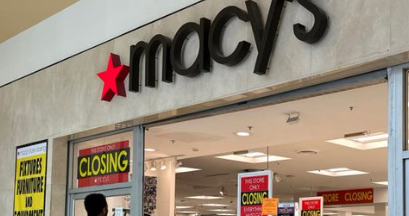Howard Davidowitz (Retail Consultant): “The retail industry is facing its greatest challenges in 50 years. We are going to see the lowest number of malls we’ve seen in decades.”
- Neil Saunders (Managing Director, GlobalData Retail): “Many of the traditional malls are struggling because they no longer fit with consumer demand and behavior. People want more than just a shopping experience; they want an experience that combines shopping, dining, and entertainment.”
Macy’s recent decision to close nearly a third of its stores will lead to significant changes in shopping malls and surrounding communities across the U.S. The retailer announced in February that it plans to shut approximately 150 of its namesake stores by early 2027. While Macy’s has not yet specified which locations will be affected, CEO Tony Spring indicated that these stores represent 25% of the company’s gross square footage but account for less than 10% of its sales.
The company plans to focus on its remaining 350 Macy’s stores and invest in new locations for its more successful brands, such as Bloomingdale’s and Bluemercury. This move reflects broader trends affecting malls and retail spaces, driven by shifts towards online shopping and changing demographics.
According to Chris Wimmer, a senior director at Fitch Ratings, the closures will accelerate the decline of less successful malls, providing opportunities for more viable shopping centers to revitalize. Many of Macy’s locations are in malls with better locations and healthier balance sheets, where mall owners are eager to repurpose valuable real estate.
Macy’s owns most of its store locations, a legacy from a time when department stores drew shoppers and generated rent for other retailers. The closures will open up space for potential new uses such as medical facilities, retirement communities, or grocery stores, aligning mall spaces with evolving local needs.
Macy’s Closures to Usher in a New Era of Mall Transformation: Apartments, Hockey Rinks, and Amazon Warehouses – https://t.co/Ljs4d7WSxn
— Brio (@Brio_NGA) August 12, 2024
However, some closures might be more problematic. In poorly located malls, the absence of Macy’s could further deteriorate the area, making it difficult to repurpose the space effectively.
Macy’s has already closed more than a third of its stores over the past decade. The company had 503 Macy’s stores as of early May, alongside other concepts. The trend of downsizing or disappearing department stores includes other anchors like Sears, Lord & Taylor, and JCPenney.
The number of malls has also decreased. Class A and B malls, which are generally better-performing, fell from 352 in 2016 to 316 in 2022. The decline is even steeper for Class C and D malls, which dropped from 684 to 287 in the same period.
Anand Kumar of Coresight Research anticipates that by 2030, top-tier malls will capture a larger share of mall spending, while lower-tier malls may close or repurpose spaces for non-retail uses. Some distressed malls may find themselves with few remaining anchors, like Macy’s, making revitalization challenging.
In response to these changes, mall owners are increasingly replacing traditional anchors with a mix of tenants, including medical offices, co-working spaces, and dining options. For example, Brookfield Properties has successfully redeveloped former Macy’s spaces into destinations with diverse offerings such as Whole Foods, movie theaters, and healthcare facilities.
Other innovative uses for former Macy’s locations include an NHL training facility near Salt Lake City and large Amazon fulfillment centers replacing old mall sites, such as those in Randall Park Mall in Ohio and Baton Rouge, Louisiana.
Quotes
- Mark Cohen (Director of Retail Studies, Columbia Business School): “What we’re seeing is a historic tipping point in retail. Malls are on the decline because they were overbuilt, and now consumers’ preferences have shifted.”
- Deborah Weinswig (Retail Analyst): “The death of the American mall is not just about the rise of e-commerce; it’s a sign of a much deeper shift in consumer behavior.”
- Rick Caruso (Mall Developer and CEO of Caruso Affiliated): “Malls are not dying. Bad malls are dying.”
- Barbara Kahn (Wharton School Professor of Marketing): “Retailers are finding it difficult to sustain the traditional brick-and-mortar model in an era where convenience and price competition are driving more consumers online.”
- Richard Hayne (CEO of Urban Outfitters): “The U.S. is oversaturated with retail space and far too many malls. The economic model of most retail companies is collapsing under the weight of this overexpansion.”
- Steve Barr (U.S. Retail Leader, PwC): “The American mall was a product of its time. But the way people shop has fundamentally changed, and malls must either evolve or face extinction.”
Key Points:
i. Macy’s will close about 150 stores by early 2027, impacting malls and communities across the U.S.
ii. The closures represent 25% of Macy’s store space but less than 10% of its sales; the company will invest in its remaining stores and successful brands.
iii. The move will accelerate the decline of lower-quality malls, but offer opportunities to revitalize better-performing centers.
iv. Macy’s closures may lead to new uses for mall spaces, such as medical facilities or grocery stores, but could also worsen conditions for poorly located malls.
v. The trend of department store closures and mall downsizing continues, with repurposed mall spaces including entertainment centers, retail spaces, and fulfillment centers.
TL Holcomb – Reprinted with permission of Whatfinger News



